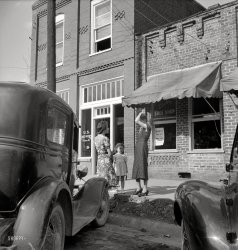
MAY CONTAIN NUTS

Search Shorpy
SHORPY ART

Framed or unframed, desk size to sofa size, printed by us in Arizona and Alabama since 2007. Explore now.
Join and Share
Ad-Free Shorpy
Shorpy is funded by you. Patreon contributors get an ad-free experience.
Learn more.

Recent comments
- Baldwin 62303
- Baldwin VO-1000
- Cold
- No expense spared
- Tough Guys
- Lost in Toyland
- And without gloves
- If I were a blindfolded time traveler
- Smoke Consumer Also Cooks
- Oh that stove!
- Possibly still there?
- What?!?
- $100 Reward
- Freeze Frame
- Texas Flyer wanted
- Just a Year Too Soon
- WWII -- Replacing men with women at the railroad crossing.
- Yes, Icing
- You kids drive me nuts!
- NOT An Easy Job
- I wonder
- Just add window boxes
- Icing Platform?
- Indiana Harbor Belt abides
- Freezing haze
- Corrections (for those who care)
- C&NW at Nelson
- Fallen Flags
- A dangerous job made worse
- Water Stop
Member Photos
The Shorpy
Print Emporium
Print Emporium
Search Shorpy
Search results -- 30 results per page
- Goes to School Now (He Says)
- On streets near Daniel Mill. Lincolnton, North Carolina. November 1908. Right hand boy is Dan Biggerstaff. 10 years old. Has ... Posted by Dave - 12/14/2007 - 3:09am -
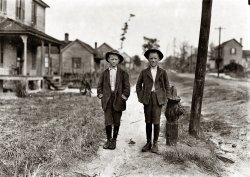
- Country Kitchen: 1939
- ... kitchen showing stove and butter churn. Person County, North Carolina. View full size. Photograph by Dorothea Lange.
Irony I work ... Posted by Dave - 11/07/2008 - 10:12pm -
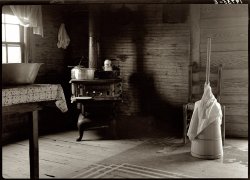
- Charley Humble: 1913
- ... Records show that Charles Franklin Humble was born in North Carolina on June 25, 1902, and died in Danville, Virginia in July 1987. His ... Posted by Dave - 03/24/2014 - 10:34pm -

- The Auto Show: 1917
- ... great-grandfather was a well-to-do man in a small town in North Carolina. (He distilled and bottled legal liquor). My grandmother told me that ... Posted by Dave - 09/12/2011 - 12:05pm -
![The Auto Show: 1917 "Washington, D.C., auto show. March 3-10, 1917." A display of Chalmers and National cars. National Photo Co. Collection glass negative. View full size.
Big cars in D.C.In these pictures of Washington, one thing that stands out to my eyes is the preponderance of BIG and expensive cars. Caddies, Packards, Pierces. Very few Fords in sight. In contemporary pics from other cities, even prosperous oil towns in Oklahoma, the only cars visible are Ford T's with perhaps an occasional Dodge.
Auto Shows Auto shows prior to WWII were a different venue than we've gotten used to in these past 60 years. Because there were very few purpose-built exhibit halls anywhere in the country, auto shows were usually held in industrial loft buildings similar to the one shown in the photo. Consequently, exhibit promoters had to do their best to turn a sow's ear into a silk purse with the sort of decorations shown. On very rare occasions, well-connected promoters could wangle permission to use a high ceilinged downtown armory.
[The Washington Automobile Show was held on the third and fourth floors of the Union Building downtown. There was an orchestra and dancing. - Dave]
Union GarageThe first person who lived in my house bought a Chalmers in 1917 from the Union Garage, which started as a place where the smaller automakers could get together to sell their cars and not have to spend big bucks on building their own showrooms. I believe that Ford used space there. The Union Garage as such didn't last long, though the building was still standing in the 60's. Today, the lot is covered by the Verizon Center. The Army Air Corps used part of the building during WWI, but moved out quickly as the air was too foul from all the exhaust.
[Below, the Union Garage in 1915. In July 1917 the building was taken over by Semmes Motor Co., which sold Dodge and Hudson cars as well as Wilcox and Vim trucks. - Dave]
Granny's ChalmersI once asked my paternal grandmother what the first car she remembered riding in was and she told me it was her father's 1917 Chalmers! My great-grandfather was a well-to-do man in a small town in North Carolina. (He distilled and bottled legal liquor). My grandmother told me that a salesman brought the car out to their house and sold it to him and someone came out to pick up the salesman. She said that eventually her older brother, Sanford, "destroyed the thing and drove it right off its frame!"
Spoken ForInteresting that both these cars have a sign on the windshield stating that they've already been sold. Wonder if this is the same Chalmers that manufactured tractors under the 'Allison Chalmers' name?
[You're thinking of Allis-Chalmers. - Dave]
(The Gallery, Cars, Trucks, Buses, D.C., Natl Photo)](https://www.shorpy.com/files/images/30747u.thumbnail.jpg)
- Harvest Time: 1939
- ... outside tobacco warehouse after auction sales. Durham, North Carolina." Medium format negative by Marion Post Wolcott for the Farm Security ... Posted by Dave - 04/10/2019 - 3:54pm -
![Harvest Time: 1939 November 1939. "Farmers looking at their checks outside tobacco warehouse after auction sales. Durham, North Carolina." Medium format negative by Marion Post Wolcott for the Farm Security Administration. View full size.
Not Exactly the JoadsThis is the second instance we've seen in the last couple of days of late-Depression farmers (first potato, then tobacco) running around in new Buicks. Surely John Steinbeck would have been surprised.
Explosive proximityThis photo was taken about five blocks from where the fatal gas explosion occurred in Durham yesterday.
Shorpy Vehicle Identification Imperative1939 Buick 4 door sedan
Taint necessarily so Standing next to a car does not mean that it is yours. A pickup would be more appropriate for the farmers seen here.
Pinstriped wheelsNotice the triple stripes on the wheels. Done by hand for sure!
[Incorrect. - Dave]
Buyer's car, perhaps?The chrome window trim identifies that '39 Buick as a Century Series 60. I would bet the car belongs to one of the tobacco buyers rather than one of the farmer/sellers.
The carThe car is a Century I reckon - it has the fatter 7.00 x 15" tyres whereas the similar looking Special was on skinnier 6.50 x 16s.
(The Gallery, Agriculture, Cars, Trucks, Buses, M.P. Wolcott)](https://www.shorpy.com/files/images/SHORPY-8c10847a.thumbnail.jpg)
- Warp Time: 1908
- December 1908. Newton, North Carolina. "Boy at warping machine. Been there two years. Clyde Cotton Mill." ... Posted by Dave - 08/18/2009 - 9:26am -
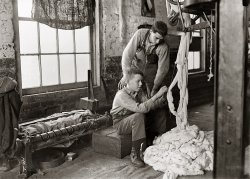
- Ready to Roll: 1942
- May 1942. Motor detachment at the New River, North Carolina, Marine base. View full size. 4x5 Kodachrome transparency by ... Posted by Dave - 07/24/2012 - 9:37pm -
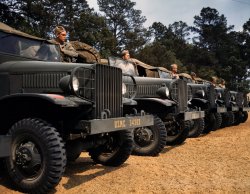
- Father Dead. Gives Money to Mother.
- ... Birch of the correct age (born 1898) appears in 1900 in North Carolina but no Stanley (who was born in 1895).
[Closest I could come was ... Posted by Dave - 07/14/2009 - 4:26am -
![Father Dead. Gives Money to Mother. May 1910. Wilmington, Delaware. "Louis Birch, 4th & Pine Streets. Newsboy, 12 years of age. Just started selling. Made 10 cents one day. Father dead. While not under any compulsion to sell papers, Louis, of his own accord, took it up in order to help support his widowed mother. Louis stays out until 12:30 every night and goes with his brother, Stanley, who is a messenger, on all calls because Stanley is afraid to be out on the street alone at night. Louis is clean, bright and willing. Visits saloons. Don’t smoke. Works 9 hours per day. Gives money to mother." Photograph by Lewis Wickes Hine. View full size.
Too young to look that tiredThe look on his face, combined with the caption, will break your heart. I wish there was some way to find out what happened to Louis and Stanley.
Figured it out.Aha! It came to me last night... the mother remarried, Louis and Stanley took their new father's last name, and thus disappear from the record.
[AT, you are a Super Genius! - Dave]
Hmm...I can't find records in the 1920 and 1930 censuses or the WWI Draft Registration for either Louis or Stanley.
[What about Burch? - Dave]
NopeNo likely matches under Burch either. A Lewis Birch of the correct age (born 1898) appears in 1900 in North Carolina but no Stanley (who was born in 1895).
[Closest I could come was a Louis Burch, born 6/28/1898, died 1/1986 in Missouri - Dave]
HeyHe looks like Toby Maguire.
(The Gallery, Kids, Lewis Hine)](https://www.shorpy.com/files/images/03591u_0.thumbnail.jpg)
- Cigarette City: 1940
- October 1940. "Durham, North Carolina. Five Points, center of city, with Chesterfield cigarette factories in ... Posted by Dave - 08/10/2019 - 9:36am -
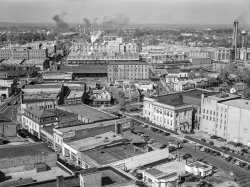
- Country Kitchen: 1939
- ... the baby after its bath in the kitchen. Person County, North Carolina, near Gordonton. Medium-format nitrate negative by Dorothea Lange for ... Posted by Dave - 09/09/2011 - 11:31am -
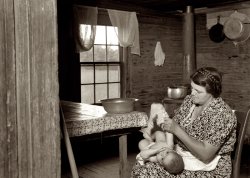
- Crowded House: 1940
- ... West Virginia; Bristol, Tennessee; or High Point, North Carolina. They are carpenters, carpenters' assistants, riggers and laborers. ... Posted by Dave - 01/06/2020 - 3:11pm -
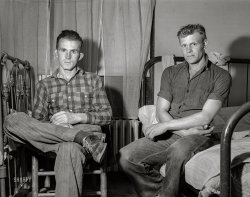
- A Bumper Crop: 1938
- April 1938. "North Carolina farmer and family. Guilford County." Medium format negative by John ... Posted by Dave - 11/24/2017 - 1:53pm -
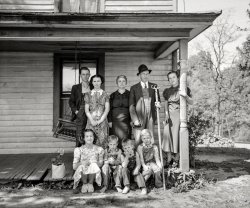
- The Reading Tree: 1939
- ... Note vegetable garden across footpath. Chatham County, North Carolina." Photograph by Dorothea Lange for the Farm Security Administration. ... Posted by Dave - 09/05/2012 - 4:10pm -
![The Reading Tree: 1939 July 1939. "Negro tenant farmer reading paper on a hot Saturday afternoon. Note vegetable garden across footpath. Chatham County, North Carolina." Photograph by Dorothea Lange for the Farm Security Administration. View full size.
ChairHaven't seen a chair like that in years. You used to see them at nearly every house out in the country. They were fairly easy to knock together from scrap wood.
[It's called an Adirondack chair. - Dave]
(The Gallery, Agriculture, Dorothea Lange, Rural America)](https://www.shorpy.com/files/images/8b34162u_1.thumbnail.jpg)
- Breakfast, Lunch and Dinner: 1939
- ... feeding chickens on Negro tenant farm. Granville County, North Carolina." View full size. Medium-format nitrate negative by Dorothea ... Posted by Dave - 09/09/2011 - 12:20pm -
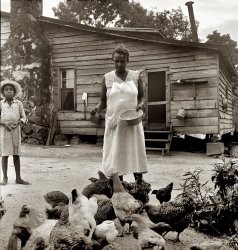
- Fort Sumter: 1865
- 1865. "Charleston, South Carolina. Breach patched with gabions on the north wall of Fort Sumter." From photographs of the Federal Navy, and seaborne ... Posted by Dave - 09/01/2011 - 7:13am -
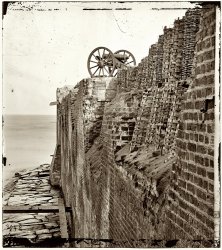
- Mechanics Hall: 1903
- ... heavier than air flight to fruition at Kitty Hawk, North Carolina.
Not all had greasy fingernails We currently regard the term ... Posted by Dave - 04/07/2016 - 10:45pm -
![Mechanics Hall: 1903 1903. "Mechanics' Hall, Boston." Last seen here. Coming in October: The 2nd Triennial Merchants & Mechanics Exposition. Plus: The Great Creatore and his Italian Band. 8x10 inch glass negative, Detroit Publishing Co. View full size.
Near the cornerWhat is the object mounted on a pedestal near the corner? Anyone?
[Police call box. -tterrace]
One Remarkable FeatureThe Boston Evening Transcript (Sept 1903) touted advances in aerial navigation mentioning Professor Langley, Santos-Dumont, and Alexander Graham Bell. Bell's models had arrived for the exposition and the others were expected to be among the manufacturers represented.
No mention of the Wright Brothers and their work. Just 2 months later, the Wright Brothers would bring controllable heavier than air flight to fruition at Kitty Hawk, North Carolina.
Not all had greasy fingernailsWe currently regard the term "mechanic' to denote one who works with the hands to build, repair, or modify machinery, whether a Ferrari or an irrigation pump. In the 19th Century, the term was more broadly construed, often embracing today's professions of builder, designer, even architect. Associational groups of such professionals sponsored continuing education, social improvement activities, and entertainment for their members. Additionally, they were often engines of change by advocating introducing professional credentialing/licensing requirements or making them more rigorous.
Thus, we see here a monument to what G. B. Shaw might have labelled a "conspiracy against the laity."
Near the cornerA police call box perhaps?
[Previously on Shorpy: Near the corner. -tterrace]
(The Gallery, Boston, DPC)](https://www.shorpy.com/files/images/SHORPY-4a11358a.thumbnail.jpg)
- Granville County: 1939
- ... whose father is in the penitentiary." Granville County, North Carolina. View full size. Medium-format nitrate negative by Dorothea Lange ... Posted by Dave - 07/24/2012 - 7:05pm -
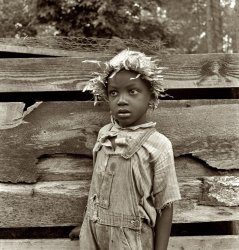
- On the Same Team: 1943
- ... 200-square-mile Marine Base, Camp Lejeune, at New River, North Carolina. Evidence of the lack of racial friction may be seen in the sports ... Posted by Dave - 08/25/2012 - 1:00pm -
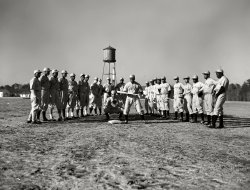
- Gaslight Alley: 1920
- Charleston, South Carolina, circa 1920. "Street scene with horse and wagon." 4x5 inch nitrate ...
Looks like Bedons Alley at Elliot Street Looking north. Here's a link to the map and streetview:
http://goo.gl/maps/qvj7L ... Posted by Dave - 01/26/2014 - 2:29pm -
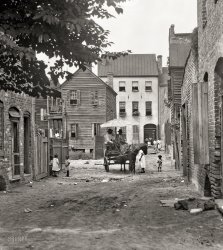
- Fair Warning: 1940
- ... store operated by Mr. Coley. Stem, Granville County, North Carolina." Photo by Jack Delano. View full size.
Arrow Beer I'd ... Posted by Dave - 11/11/2018 - 6:18pm -
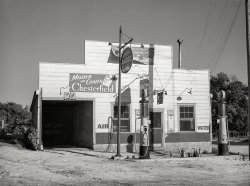
- F.B.I. Artiste: 1938
- ... before I painted it. It's from things I remember about North Carolina, my home."
Sam, who has been painting since 1910, is completely ... Posted by Dave - 08/28/2012 - 5:58pm -
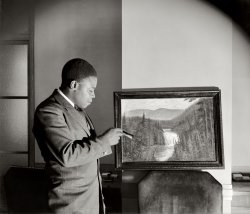
- Tenant Farmer: 1939
- July 1939. Tenant farmer in Chatham County, North Carolina. View full size. Farm Security Administration photograph by ... Posted by Dave - 07/30/2012 - 2:40pm -
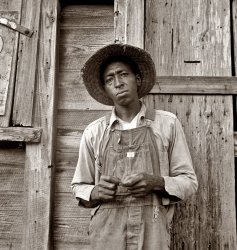
- The Crime Car: 1941
- ... 'crime museum' traveling sideshow near Fort Bragg, North Carolina." Medium format negative by Jack Delano. View full size.
... Posted by Dave - 11/30/2018 - 11:18am -
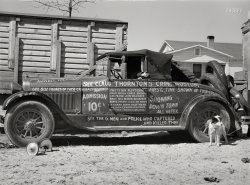
- Keep a Light On: 1940
- ... and nights and almost another hitchhiking from my base in North Carolina to home in northwest Pennsylvania. I saw lots of scenes like this one ... Posted by Dave - 01/03/2020 - 7:54pm -
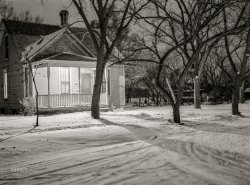
- The Good Earth: 1940
- ... are those of a neighbor. Near Farrington, Chatham County, North Carolina." Photo by Jack Delano for the Farm Security Administration. View ... Posted by Dave - 04/01/2019 - 12:34am -
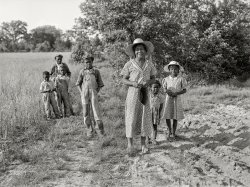
- How to Bed a Balloon: 1942
- ... the series last seen here . "Parris Island, South Carolina. Special Marine units learning how to bed down a big barrage balloon." ... it as a mode of transporting these devil balloons over to North America.
Limited Utility One sees what seem to be hundreds of ... Posted by Dave - 05/25/2013 - 3:42pm -
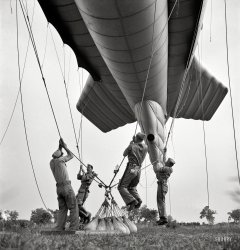
- Marlboro Boy: 1939
- ... fire next to flue of the curing barn. Granville County, North Carolina. View full size. Medium-format nitrate negative by Dorothea Lange ... Posted by Dave - 02/07/2008 - 2:27am -
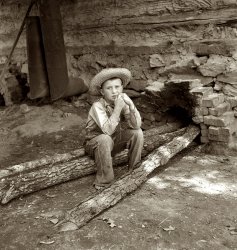
- Life on the high sea
- ... Croatan Shoal Light, NC It's the Croatan Shoal light in North Carolina. Click for info.
I know you said it was waterfront ... Posted by Samuel1940 - 09/20/2011 - 8:50pm -
![Life on the high sea Location: Unknown. Date: Unknown. This home appears to be a true light house. One can imagine it didn't last many storms. View full size.
A Screw-Pile LightThis is an example of a screw-pile lighthouse, of which indeed only a few remain. The did indeed screw the pilings into the bottom. They were particularly popular in the Chesapeake Bay region, but they saw use in NC and along the gulf coast too, and there are a number of monster versions along the Florida coast.
They were actually pretty tough in the face of storms, particularly since they were mostly used in more sheltered locations where they didn't have to deal with ocean storm waves. Their real nemesis (besides the USCG, which tended to remove the house once they became automated) was ice, which would ride up the piles and push the house off the foundation. There were several instances in which the house ended up being carried down the bay, occupants and all.
I can't identify this particular light with any certainty, but it might be the Lower Cedar Point Light on the lower Potomac River.
Croatan Shoal Light, NCIt's the Croatan Shoal light in North Carolina. Click for info.
I know you saidit was waterfront property but this is rediculas.
[We used to summer at Rediculas. - Dave]
(ShorpyBlog, Member Gallery)](https://www.shorpy.com/files/images/waterhouseunknown.thumbnail.jpg)
- Hyphen House: 1939
- ... (Dr. Gideon Hunt Macon), Airlie vicinity, Halifax County, North Carolina." Seen earlier here from a different vantage. 8x10 inch acetate ... Posted by Dave - 01/05/2013 - 11:36am -
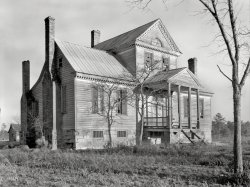
- Electric Shoe Shop: 1939
- ... "Street encounter on a Saturday afternoon. Pittsboro, North Carolina." Medium-format nitrate negative by Dorothea Lange. View full size. ... Posted by Dave - 11/14/2012 - 5:36am -
